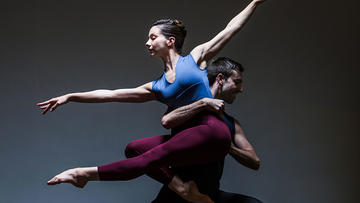'Dance as Grace: Paradoxes and Possibilities' | KE Fellowship seminars
'Dance as Grace: Paradoxes and Possibilities': two KE Fellowship seminars incorporating live dance performances.
18 and 19 June 2021. Jacqueline du Pré Music Building, St Hilda’s College Oxford.
The Grace Project is an interdisciplinary investigation into the concept of ‘grace’ in all its forms, which evolved from the research of Professor Sue Jones on literature and dance. Grace has been central to the development of dance aesthetics, but it has also been challenged by practitioners of modern and contemporary dance. These two seminars, which were attended by socially-distanced groups of academics, practitioners and interested local people, interrogated the question of what constitutes grace by examining five contrasting dances performed by, and discussed with, members of the Yorke Dance Project led by Yolande Yorke-Edgell.
The dancers presented works by Robert Cohan, Kenneth Macmillan and Yorke-Edgell, the latter consciously channelling the influences of Richard Alston and Bella Lewitzky (who was herself influenced by the choreographer Lester Horton).
The first and last dances were ‘Drowning’ and ‘The Book’, excerpts from Macmillan’s work Sea of Troubles (1988), carefully revived for the company by Susie Crow, Stephen Wickes and notator Jane Elliot. The work conveys the psychological dilemmas presented by the characters in Shakespeare’s Hamlet deconstructing the play though a succession of vignettes. Both the scenes shown contain overt violence and brutality: Hamlet holds Ophelia by the neck; he thrusts his book at her so hard that it falls and slams onto the stage; Ophelia clings to his leg, like a child clinging to a parent who is beating them. The Ghost is a constant presence lying centre stage, while Gertrude and Claudius stalk with hubristic processional steps that both cloak and expose their sensual relationship. The dancers interchanged roles (using crowns, a garland, and a transparent white shirt to indicate whether they were Gertrude and Claudius, Ophelia, or the Ghost), which both elevated and reduced them to archetypal embodiments of the darkest human emotions.
Yorke Edgell presented two extracts from her work Imprint (2019), which drew on and embodied her memory and experience of working in the studio with Alston and Lewitzky. The duet danced by Ed Mitton and Ellie Ferguson captured the playful lyricism, catching and holding, and musicality of Alston’s work as they seemed to swim in the air. In contrast, the quartet inspired by Lewitzky used strength, gravity and counterbalance to create beautiful three-dimensional shapes in designs that drew attention to the space around the dancers’ bodies, as well as to their bodies in the space.
The two dances by Cohan were a new solo, created towards the end of his life in ‘lockdown’ and the Trio from his late work Communion (2019). The solo, danced on this occasion by Pierre Tappon (and consequently named Pierre’s Solo), was part of one of Cohan’s last projects, ‘Afternoon Conversations with Dancers’, in which he created a collection of solos on individual dancers, the first two in the studio, the later ones on Zoom. This solo reflected the frustration and confinement of the pandemic: other solos were filmed on location, and although Cohan was not specific about the site he envisaged for this particular dance, it felt as if it belonged in a busy city surrounded by high buildings. Tappon’s huge open running steps and sudden stops, as if thrust up against a wall, were extraordinarily powerful. There was contrast between movement and stillness, energy and falling back, speed, dynamism, and the constraint of space, as Tappon anchored himself to the floor with a leg or an arm, turning around and around, and in upon himself. At the end he reached upward, feet in fifth position, in a moment of verticality before subsiding, breathing heavily, to the ground.
This was in complete contrast to the harmony, balance and calm of the second Cohan dance shown. In an excerpt from Communion, Freya Jeffs, Ellie Ferguson and Abigail Attard-Montalto seemed to drift, like leaves slowly circling in the sky, pausing to rest then gently and rhythmically flicking their hands open as if they were casting light into the air. The rhythm and suspension of triplet motion and the serenity of the gliding dancers was mesmerising. This dance was originally set to a faster piece of music, and Yorke-Edgell, artistic director Stephen Pelton and the dancers talked about the different ways in which choreographers use or align with composers’ choices.
Discussion during the two seminars was cross disciplinary, considering what constitutes grace in dance and how our ideas about physical grace interact with literary, artistic, scientific, musical, biomechanical, theological and philosophical understandings of grace. Approaching grace through the medium of dance frees us from some of the semantic ambiguity that can obscure it. It led me to conclude that the adjectives and nouns derived from the word ‘grace’ or the Greek Χάρις (charis) such as ‘graceful’, ‘gracious’, ‘charisma’ or ‘charity’ although sometimes helpful can be a distraction from its essence. The dancers showed that grace can reside in movement that is not conventionally graceful, in disruption and in stillness. The delicate balance between the dance work itself and its performance depends on the surrender of choreographer and dancer to the creative process; without that truth, obedience and humility, the dance will not have grace. Thinking in terms of dance releases us from linguistic constraint and opens us up to understanding grace as a freely given gift, which we recognise by experiencing it.
Maggie Watson, Bodleian Law Library
23 June 2021
Knowledge Exchange project page of Professor Sue Jones Dance as Grace: Paradoxes and Possibilities

Image credit: Johnny Buzzerio


